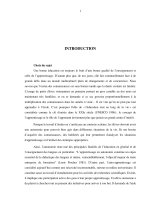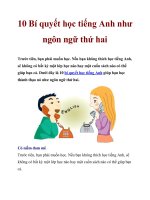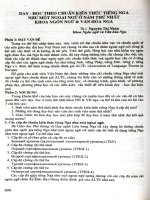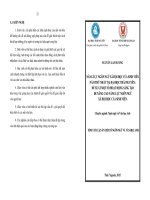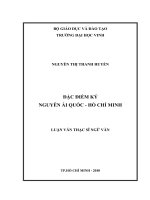Nguyễn Trâm Anh, Thái Ngọc Minh, Huỳnh Nhật Huỳnh- Ngôn Ngữ Anh 15B.docx
Bạn đang xem bản rút gọn của tài liệu. Xem và tải ngay bản đầy đủ của tài liệu tại đây (291.18 KB, 63 trang )
TAY DO UNIVERSITY
FACULTY OF FOREIGN LANGUAGE
CROSS-LINGUISTIC COMPARISON OF VIETNAMESE
AND ENGLISH AND SOME COMMON PROBLEMS IN
YOUR OWN CRICUMSTANCES
Supervisor:
Student:
Dang Thi Bao Dung.Ph.D.
Thai Ngoc Minh,
Nguyen Tram Anh,
Huynh Nhat Huynh.
Class: English 15B.
November,2023
ACKNOWLEDGEMENTS
I would like to express my sincere gratitude to my supervisor, Dang Thi Bao Dung,
for her dedicated help. She always gives me valuable guidance, constructive feedback
and necessary corrections with the aim of leading my harvest in the right direction.
Furthermore, she was willing to provide me with many references while I was
conducting my research. Honestly, my harvest paper could not have been completed
without her encouragement and guidance.
COMMENTS
.........................................................................................................................................
.........................................................................................................................................
.........................................................................................................................................
.........................................................................................................................................
.........................................................................................................................................
.........................................................................................................................................
.........................................................................................................................................
.........................................................................................................................................
.........................................................................................................................................
.........................................................................................................................................
.........................................................................................................................................
.........................................................................................................................................
.........................................................................................................................................
.........................................................................................................................................
.........................................................................................................................................
.........................................................................................................................................
.........................................................................................................................................
.........................................................................................................................................
.........................................................................................................................................
TABLE OF CONTENTS
ACKNOWLEDGEMENTS....................................................................................
COMMENTS...........................................................................................................
CHAPTER 1: AN TRODUCTION INTO ENGLISH LANGUAGE
1.1
The English language...............................................................................
1.2 Introduction...................................................................................................
1.3 Alphabet........................................................................................................
1.4 Phonology.....................................................................................................
1.5 Grammar.......................................................................................................
1.6 Vocabulary....................................................................................................
CHAPTER 2: AN TRODUCTION INTO VIETNAMESE LANGUAGE..........
2.1 The Vietnamese language...........................................................................
2.2 Introduction.................................................................................................
2.3 Alphabet......................................................................................................
2.4 Summary of influences...............................................................................
2.5 Pronunciation..............................................................................................
2.6 Six tones.....................................................................................................
2.7 Short vowels...............................................................................................
2.8 Grammar.....................................................................................................
2.9 Inflection.....................................................................................................
2.10 Verbs.........................................................................................................
2.11 Articles......................................................................................................
2.12 Word order................................................................................................
2.13 Vocabulary................................................................................................
CHAPTER 3: CROSS-LINGUISTIC COMPARISON OF VIETNAMESE AND
ENGLISH.................................................................................................................
3.1 Phonology...................................................................................................
3.1.1 Consonants.............................................................................................
3.1.2 Vowels...................................................................................................
3.2 Syllable Structure........................................................................................
3.3 Lexical Semantics.......................................................................................
3.3.1 Lexical Tones........................................................................................
3.3.2 Lexical Function....................................................................................
3.3.3 Classifiers..............................................................................................
3.3.4 Pronouns................................................................................................
3.3.5 Word Formation.....................................................................................
3.3.6 Morpho-Syntax......................................................................................
3.4 Potential Vietnamese-English Interactions..........................................................
3.4.1 Vietnamese Transfer to English...........................................................
3.4.2 English Transfer to Vietnamese...........................................................
CHAPTER 4: SOME COMMON PRONOUNCIATION PROBLEMS FACING
VIETNAMESE LEARNERS OF ENGLISH........................................................
4.1 Some common pronunciation problems in English...........................................
4.1.1 Problems with vowels................................................................................
4.1.2 Problem with /i:/ versus/I/..........................................................................
4.1.3 Problem with /u:/ versus /u/.......................................................................
4.1.4 Problem with /e/ versus/ æ/........................................................................
4.1.5 Confusion between/l/ and /v/......................................................................
4.2 Problems with consonants.................................................................................
4.2.1 Problem with voiced versus voiceless stops...............................................
4.2.2 Problem between consonants /s/ and/z/......................................................
4.2.3 Problem with /θ/ and/ ð/.............................................................................
4.2.4 Problem with/p/ vs. /f/ and /b/....................................................................
4.2.5 Problem with liquid/l/ and nasal/n/.............................................................
4.2.6 Consonant clusters.....................................................................................
4.2.7 Problem with grammatical ending s...........................................................
4.3 Word stress and tones........................................................................................
4.4 Tense and Aspect in English.............................................................................
4.5 Copula in English and in Vietnamese................................................................
4.5.1 The Copula in English..............................................................................
4.5.2 The copula in Vietnamese........................................................................
4.6 Phrasal Structures in English and in Vietnamese............................................
4.6.1 Phrasal Structures in English................................................................
4.6.2 Phrasal Structures in Vietnamese...........................................................
4.7 Common Problems of Vietnamese Learners of English with Tense and Aspect,
the Copula be, and Phrasal Structures.......................................................................
4.7.1 Common Problems with Tense and Aspect...........................................
4.7.2 Common Problems with the Copula be..................................................
4.7.3 Common Problems with Phrasal Structures...........................................
REFERENCES.............................................................................................
CHAPTER 1: AN TRODUCTION INTO ENGLISH LANGUAGE
1.1
The English language
It is crucial to acknowledge right once that there are various dialects or variants of
English. American native English speakers differ from British native English speakers
in their use of grammar, vocabulary, and pronunciation. In fact, there are spoken
English variations inside Britain itself that are largely incomprehensible to one
another.
1.2
Introduction
The Indo-European language family includes the Germanic language family, of which
English is a member. From Canada to New Zealand, there are more than 350 million
native speakers of this language in various nations throughout the world. In many
more, it serves as the second or joint official language.
English is the most widely studied second language and the language of world politics
and business.
1.3
Alphabet
The English alphabet consists of 26 Roman letters.They also do not have diacritics
like in Vietnamese and French.The exception is words imported from other languages,
e.g. attaché,Cliché from French. However, these words are increasingly written
without the diacritic, even in formal English.
Although the varieties of spoken English sound very different, all native- speakers use
the same writing conventions.
A
H
O
V
1.4
B
I
P
W
C
J
Q
X
D
K
R
Y
E
L
S
Z
F
M
T
G
N
U
Phonology
Standard English has about 20 vowel sounds (12 pure vowel/8 dipthongs) and about
24 consanant sound. Speakers os language which have fewer vowel sounds often have
difficulty making a distinction between words like meet/meat; die/dye; for/four;…The
same applies to the consonants cluster in many English words: bright, green, sphere.
Non-native speakers may say such words with an extra wowel sound or leave out the
syllable altogether.
The pronunciation of English words such as compose, second, extra inevitably causes
problem for learners who do not need to use the tip of the tougue to produce words in
their own language.
Further difficulties for learners attempting to produce spoken English that sounds
natural are the unpredictapbility of English word stress, the elision of the weak
syllables and the insertion of consonant (liaison).
Single vowel
Short vowels
Long vowels
Diphthongs
/i/
/i:/
/ir/ or /ie/
/e/
/æ/
/er/ or /ee/
/ʊ/
/in:/
/no/
/ʌ/
/a:/
/ɑi/
/o /
/ ɔ :/ or /ɔ:r/
/ʊə/ or /ʊr/
/е/
/ ɜ :/
/ ɑʊ /
/ ɔ i/
/ əʊ / _
Voiced
consonants
Voiceless consonants
The remaining
consonants
/b/
/g/
/v/
/z/
/d/
/dʒ/
/ð/
/ʒ/
Examples:
/p/
/f/
/s/
/ʃ/
/k/
/t/
/θ/
/tʃ/
/m/
/η/
/l/
/j/
/n/
/h/
/r/
/w/
Photograph – Photography (stress words)
You wanna – I dunno (Elision)
Fa(r) away/ mo(r)e ice
English is a stress-timed language. Its intonation patterns, therefore, are different from
those of syllable-timed languages like French, Spanish or Hindi. This accounts for the
heavy English accents that many native speakers of those language retain even after
years of speaking English and the acquisition of flawless grammar.
1.5
Grammar
In one respect English verb grammar is easy. It does not have la large number of
inflections such as exist in French or Russian.
For example, there are only 4 forms of the regular verb to 1 2 3 4. On the other hand,
English does have a large number of possible tenses (verb forms); and their
designations are not always helpful to the learner. The past simple tense, for example,
can be used to talk about the future: If I won a lot of money, I would buy a new house.
Many languages do not have a continuous tense form, so English learners may make
mistakes such as: I had a bath when the phone rang. rench. en in ve- ls/ ch Indeed, the
most significant problem for learners is to decide which tense (verb form) is required
in English to correctly express the meaning that they wish to convey. A further feature
of verb grammar that causes difficulties is the correct choice of modal. Modal verbs
are heavily used in English to convey shades of meaning in the areas of compulsion,
ability, permission, possibility, hypothesis, etc.
For example, learners have problems understanding the difference between: He must
have done it and He has had to do it.
Grammar - Other: Not only are verbs largely uninflected in English, but also nouns,
pronouns and adjectives. The articles and other determiners never change their form*.
This makes it much easier to avoid mistakes in English than in, say, German which
has large numbers of inflections in the various parts of speech. Meaning in English is
conveyed largely by word order. In the following sentences we know who is biting
whom by the order of the words: The dog bit the man. / The man bit the dog. Compare
this with German. Because German is a highly inflected language, a more flexible
word order is possible. So, Den Hund biss der Mann translates as The man bit the dog.
Word order in English sentences becomes significantly more difficult when indirect
objects or adverbials are added to the standard Subject-Verb-Object syntax. Most
learners of English have problems ordering words correctly in longer, more complex
clauses. The article system is another feature of English grammar that causes some
students enormous difficulties; particularly, of course, those whose native languages
do not use articles.
1.6
Vocabulary
English has the largest vocabulary of any language. Depending on counting methods it
has approaching one million words. The Anglo-Saxon lexical base has been
supplemented by the influx of words from Latin and Greek, from French and the
languages of countries colonized by England.
English shares cognates with most other languages, but a significant number of these
are 'false friends'. For example, the German / English words Maus/mouse; Antenne /
antenna; trink! drink! are identical in meaning and virtually so in pronunciation. The
German word sensibel, however, translates as sensitive, not sensible. and is stressed
on the second syllable. Similarly, the German word also does not mean too as in
English, but therefore, and is pronounced to rhyme with shall (not all).
A significant feature of English vocabulary that can cause severe difficulties for
learners are phrasal verbs. Sentences such as I put it down to the weather, or I made it
up with my sister, are usually impenetrable to non-native speakers. Unfortunately,
phrasal verbs are extremely common in colloquial language, where they are inevitably
preferred to their equivalents whose source is Latin or Greek (put down to = attribute /
make up with = reconcile.
CHAPTER 2: AN TRODUCTION INTO VIETNAMESE LANGUAGE
2.1 The Vietnamese language
Vietnamese is an Austroasiatic language spoken primarily in Vietnam where it is the
national and official language. Vietnamese is spoken natively by around 85 million
people, several times as many as the rest of the Austroasiatic family combined. It is
the native language of the Vietnamese (Kinh) people, as well as a second or first
language for other ethnic groups in Vietnam. It is split into three main dialects,
Northern (Hanoi), Central (Hue), and Southern (Ho Chi Minh City).
2.2 Introduction
Vietnamese is the official language of Vietnam. It’s spoken by about 75 million
people in and around Vietnam plus a few million living overseas.The biggest overseas
Vietnamese population is in the USA and in fact Vietnamese is the 6th most widely
spoken foreign language in the USA (and, can you believe, the 3rd most widely
spoken foreign language in Texas).
For over 1,000 years Vietnam was occupied by the Chinese and this had a huge
influence on the language. For a start, Vietnamese was first written using a subset of
Chinese characters. During this time also many Chinese words crept into Vietnamese
and this means that approximately 30-50% of Vietnamese vocabulary is derived from
Chinese.
2.3 Alphabet
In the 17th Century Jesuit priests from Portugal started writing Vietnamese in the
Roman alphabet, albeit with Portuguese influences and a few extras diacritics to take
into account sounds not in Portuguese.
By the time of the French occupation (1862-1945) the alphabet was settled with 29
letters in all:
Aa
Ii
Rr
Ăă
Kk
Ss
Ââ
Ll
Tt
Bb
Mm
Uu
Cc
Nn
Ưư
Dd
Oo
Vv
Đđ
Ơơ
Xx
Ee
Ơơ
Yy
Gg
Pp
Hh
You’ll notice there’s no F, J, W, or Z and sometimes pronunciations are very different
so that one letter may represent several different sounds. In addition you’ll see some
letters with tone marks on them to show the 6 different tones in Vietnamese (more on
this later).
While the French were in Vietnam they also introduced new vocabulary as well
though obviously not as much as the Chinese who had come before them.
After the French it was the turn of the Americans who brought with them new English
vocabulary for more modern terms. More recently still the influence of the West has
been through mass media and the internet with new words being introduced into
Vietnamese from English.
2.4 Summary of influences
So to sum up, here’s how the history of Vietnamese will affect your teaching:
Vietnamese beginner students will often have a basic set of English words which they
already know even if they are pronounced differently
Although the alphabet looks similar to the English alphabet, there are a great many
differences and this can lead to problems of reading and pronunciation amongst
Vietnamese speakers
2.5 Pronunciation
One of the major problems all teachers with Vietnamese students talk about is
pronunciation.
In general, Vietnamese students have poor English pronunciation and it takes a lot of
practice and effort to overcome this and help them.
The reasons are fairly straightforward:
many school emphasize speaking from the word go and push their students into
speaking English before they are ready
there is a lack of native (or near-native) English speakers teaching in Vietnam
and students get little exposure to live language
students get too little input in good English in general; they simply don’t hear
enough English to pick up the rhythms and intonation patterns
More specifically:
some sounds do not exist in Vietnamese: the glottal stop, plosives and voiceless
consonants for example and these can prove difficult
grouped consonants are almost non-existent in Vietnamese: exclamation,
english, abstract and so on are difficult
Vietnamese words are almost exclusively short and of one syllable only; longer
English words can prove problematic
because Vietnamese words are short this means word stress is not an issue; in
English the opposite is true
2.6 Six tones
In addition, Vietnamese has up to 6 tones which means the way in which a word is
said can change its meaning. These tones are shown as diacritics on the letter, for
example:
Tiếng Việt
Example
English
(unmarked)
ma
Meaning
Ghost
(không dấu)
Rising tone
Dấu sắc
Falling tone
Dấu huyền
Falling rising Dấu hỏi
◌́
`
◌̉
má
mà
mả
Mother
But
Tomb
tone
High
~
mã
Horse
.
mạ
Rice seedling
Level tone
Dấu ngang
rising Dấu ngã
tone
Low
Dấu nặng
Marker
constricted
tone
Bearing in mind that English is not tonal this means Vietnamese students often have
problems with sentence intonation (e.g. at the end of a question).
2.7 Short vowels
There are no short vowels in Vietnamese. This means students will pronounce:
Seat as Sit
Feat as Fit
2.8 Grammar
Vietnamese grammar is very different from English grammar. This section covers a
few major areas you’re likely to encounter teaching Vietnamese native speakers.
2.9 Inflection
Vietnamese does not inflect (that is, words don’t change to show grammatical case or
plurals or possession, etc)
This means you must explain very carefully and specifically how words change and
why. For example:
possession is shown by ‘s
plurals are shown by -s
I as a subject and me as an object
2.10 Verbs
In Vietnamese verbs do not conjugate like English verbs do to show tense. Instead
time is often shown simply by using adverbs:
I go to the movies yesterday.
Because the sentence contains the adverb yesterday it’s obvious that the event took
place in the past so there is no need in Vietnamese to conjugate the verb and put it in
the past tense. If the context is obviously in the past, present or future then
Vietnamese doesn’t bother with conjugation.
But you need to explain that in English it’s imperative to conjugate!
Very generally speaking beginners will have a lot of problems with making and using
correctly the different verbs and forms in English. Intermediate students will be able
to handle past & present and future but the big issue is always between simple and
progressive tenses.
Another area of difficulty when it comes to verbs is making and using the passive
voice which, in Vietnamese, is made and used very differently.
Again you need to break it down and keep it simple!
2.11 Articles
In Vietnamese there’s no difference between the definite and indefinite article so
you’ll hear students confusing them:
* Would you like the apple? I’ve got several here.
* Will you see a new film with Stallone? It’s out this week!
2.12 Word order
Although there are similarities between Vietnamese and English in regards to word
order, in Vietnamese it’s a lot more flexible.
This means that, for example, question words (who, what, where, etc) can end up at
the end of a question rather than at the beginning which must happen in English.
Again, you need to keep things simple and stick to SVO with beginners and make sure
they do. Syntax needs to be carefully explained and rules applied till your students are
more than confident with them and can handle the exceptions!
2.13 Vocabulary
Vietnamese vocabulary is one of the three basic components of Vietnamese, besides
phonetics and grammar. Vietnamese vocabulary is the basic research object of
Vietnamese lexicology, and is also the indirect research object of Vietnamese
grammar, Vietnamese phonetics, Vietnamese stylistics, Vietnamese lexicography,...
The field of Vietnamese lexicography, which studies aspects of Vietnamese
vocabulary, has only developed strongly in recent times.
Today, apart from Vietnamese words borrowed from Chinese or Indo-European
languages, all remaining words are considered pure Vietnamese words. These socalled pure Vietnamese words are often part of the original vocabulary of Vietnamese,
representing the most basic things, phenomena, and concepts that have existed for a
long time. If we compare the words in this purely Vietnamese part with corresponding
words in Muong, Tay-Thai, and Mon-Khmer languages, we see that they have certain
phonetic and semantic similarities. Since then, linguists have put forth the following
three main hypotheses about the origin of Vietnamese:
Pure Vietnamese words:
If we consider pure Vietnamese words as the result of long-term contact and
interaction between South Asian languages and Tay-Thai languages, these words form
the most basic and oldest vocabulary class in Vietnamese. , can be divided as follows:
Words corresponding to Muong language are: [tail, claw, mouth, horn,...]; [cô gái, đàn
ông, vợ, chồng,...]; [cây, củ, cơm, mả,...]; [bí, cỏ, chuối, hành,...], [bướm, cáo, cầy,
chuột,...]; [bẩn, cay, chậm, dài,...], [ăn, bơi, cấy, chạy,...]'
Words corresponding to Tay-Thai languages such as: bánh, bóc, buộc, đường, gọt,
ngắt, ngọn, rẫy, vắng...
Words corresponding to Vietnamese-Muong and Tay-Thai languages such as: bão, bể,
dao, gạo, ngà voi, sống...
Words corresponding to Bru in western Quang Binh: bụng, bốc, bớt, củi, đêm, Mặt
Trăng, mặt trời, núi, rắn, chuột...
Words corresponding to the Viet-Muong and Mon-Khmer groups in the Central
Highlands: dốc, đèo, khói, mây, mưa, rừng, sấm,...]; [da, đầu gối, mỡ, người,, thịt,...];
[ bọn, mày, nó,...]; [bếp, cày, chổi, cuốc, ruộng,...]; [bịt, bóp, bú, bưng, cắn, cắt, đứng,
gãi, hét, lắc, mặc, nghĩ, ngồi, phá, quăng, ôm, rụng, tát, về, xé,...]
Words corresponding to the Viet-Muong group and Mon-Khmer languages in general:
[một, hai, ba, bốn, năm,...]; [con, cháu, người]; [đất, đá, gió,...]; [cằm, chân, cổ,
lưng,...]; [ cắt, đẻ, kẹp, liếc,...]; [ao, cá, chim, lá,...]; [cong, già, mới, ngát]
During the period when the national language did not yet exist, pure Vietnamese
words could only be written in Nom.
Words of Chinese origin
Contact between Vietnamese and Chinese began when China's Han Dynasty invaded
Vietnam and assimilated the Vietnamese people during the thousands-year-long
period of Northern domination. This long-term contact process has introduced into
Vietnamese a very large amount of Chinese words. This phenomenon occurs
differently in different periods. The first stage was sporadic and sporadic, mainly
through oral communication through contact between Vietnamese and Han people.
Only in the Tang Dynasty did the Vietnamese language systematically receive
Chinese words through books. These Chinese-origin words are mainly read according
to the phonetics of the Tang Dynasty, following the Vietnamese phonetic principles
called Sino-Vietnamese sounds. For example: phiền, phòng, trà, trảm, chủ... Words of
Chinese origin but not read according to Sino-Vietnamese pronunciation, in addition
to words introduced into Vietnamese before the Tang Dynasty (for example, ancient
Chinese sounds corresponding to The above Sino-Vietnamese sounds are buồn,
buồng, chè, chém, chúa...), it is also necessary to mention words originating from
different Chinese dialects (such as Cantonese, Chaozhou,... ) were introduced through
oral language such as ca la thầu, mì chính, xì dầu, bánh pía, sương sáo, lẩu...
Word Indo-European origin
Since Vietnam became a French colony, French has had a significant influence on
Vietnamese and words of French origin have penetrated quite a lot into Vietnamese,
only after Sino-Vietnamese words. This influence is due to the fact that French is used
in State documents and papers and in school teaching, as well as in other types of
books and newspapers. This influence led to the appearance of many words of French
origin in many different fields such as:
•
Name of dish: bít tết, kem, pho mát, rượu vang, xúc xích, xúp, xốt,...
•
Clothing names: may ơ, si líp, sơ mi, vét tơng, gi lê, len, đầm,...
•
Drug name: calci, vitamin, pênixilin,...
•
Military terms: lơ cốt, đoan, com măng đơ,...
•
Musical terms: tăng gơ, ácmơnica, viơlơng,...
•
Scientific and technical terms: bê tông, cao su, ô tô,…
At the same time, through French, some English and German words were also
introduced into Vietnamese, for example: mít tinh, boong ke,...
In addition, Russian influence also led to the introduction of a number of Russian
words such as Bolshevik, Soviet,...
Word mixed race
The word mixed breed is to use a mixture of the above three types.
For example:
vơi hố (Sino-Nom:𥔦化) - "vơi" is purely Vietnamese, "hố"is Sino-Vietnamese.
ơm kế -"ơm"is a foreign word, "kế"is Sino-Vietnamese.
nhà băng - "nhà"is pure Vietnamese, "băng"is a foreign word.
CHAPTER 3: CROSS-LINGUISTIC COMPARISON OF VIETNAMESE AND
ENGLISH
3.1 Phonology
A comparison of Vietnamese and English may begin at the smallest unit of language:
the phoneme or speech sound. A phoneme is defined as “the smallest phonetic unit in
a language that is capable of conveying a distinction in meaning” (American Heritage
Dictionary, 2000). Vietnamese has three types of phonemes: tones (sometimes
referred to as
tonemes), consonants, and vowels. English phonemes consist of

